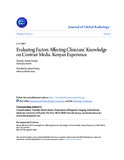| dc.contributor.author | Mutala, Timothy M | |
| dc.contributor.author | Maina, Priscilla N | |
| dc.date.accessioned | 2018-01-18T09:21:46Z | |
| dc.date.available | 2018-01-18T09:21:46Z | |
| dc.date.issued | 2017 | |
| dc.identifier.citation | Mutala, Timothy Musila, and Priscilla Nyambura Maina. "Evaluating Factors Affecting Clinicians’ Knowledge on Contrast Media: Kenyan Experience." The Journal of Global Radiology 3.1 (2017): 1. | en_US |
| dc.identifier.uri | https://escholarship.umassmed.edu/jgr/vol3/iss1/1/ | |
| dc.identifier.uri | http://hdl.handle.net/11295/102379 | |
| dc.description.abstract | Purpose: Our study aimed to establish exposure to and level of knowledge about contrast media among non-radiological clinicians and evaluate the contributory factors to the status.
Methods and Materials: A cross-sectional study was conducted between April and December 2015 through interviews using structured questionnaires. We recruited 197 non-radiological clinicians with experience in use of contrast media in their routine practice. They were of different cadres and years of experience, all working in a large referral hospital in Kenya. Levels of basic knowledge on contrast media were evaluated through a scoring system after each clinician responded to the questions provided. We also sought for training on contrast media among these clinicians and where applicable the source of the same recorded. Descriptive and inferential statistical methods were applied across the different clinicians’ subsets.
Results: Thirty-seven respondents representing 18.8% of the study sample had received formal training on contrast media. Mean knowledge score for all clinicians in this study was 14.6 translating to 14.1% of a set maximal theoretical score of 103 points. The standard deviation was 5.5. Analysis of variance (ANOVA) test for knowledge mean score among different cadres gave a P value 0.079. Unpaired t-test gave a two- tailed P value 0.2410 for mean score when trained and untrained clinicians were compared. The level of knowledge (mean score) when analysed against years of experience for the clinicians produced statistically significant results with P value 0.001084.
Conclusion: Training and knowledge on contrast media can be profoundly low for clinicians. However, there is a possibility of knowledge improving from experience in practice due to multidisciplinary interaction and the implied advantage of encapsulated knowledge. | en_US |
| dc.language.iso | en | en_US |
| dc.publisher | University of Nairobi | en_US |
| dc.rights | Attribution-NonCommercial-NoDerivs 3.0 United States | * |
| dc.rights.uri | http://creativecommons.org/licenses/by-nc-nd/3.0/us/ | * |
| dc.subject | contrast media, knowledge, clinicians, specialty, global radiology | en_US |
| dc.title | Evaluating factors affecting clinicians’ knowledge on contrast media: Kenyan experience. | en_US |
| dc.type | Article | en_US |



